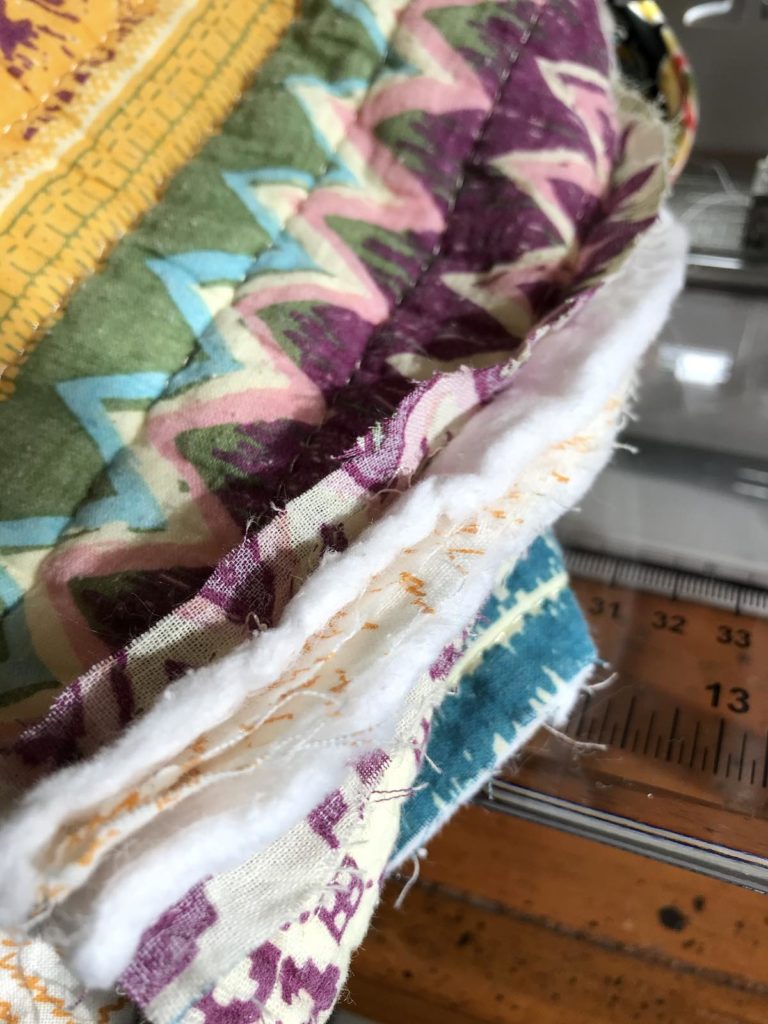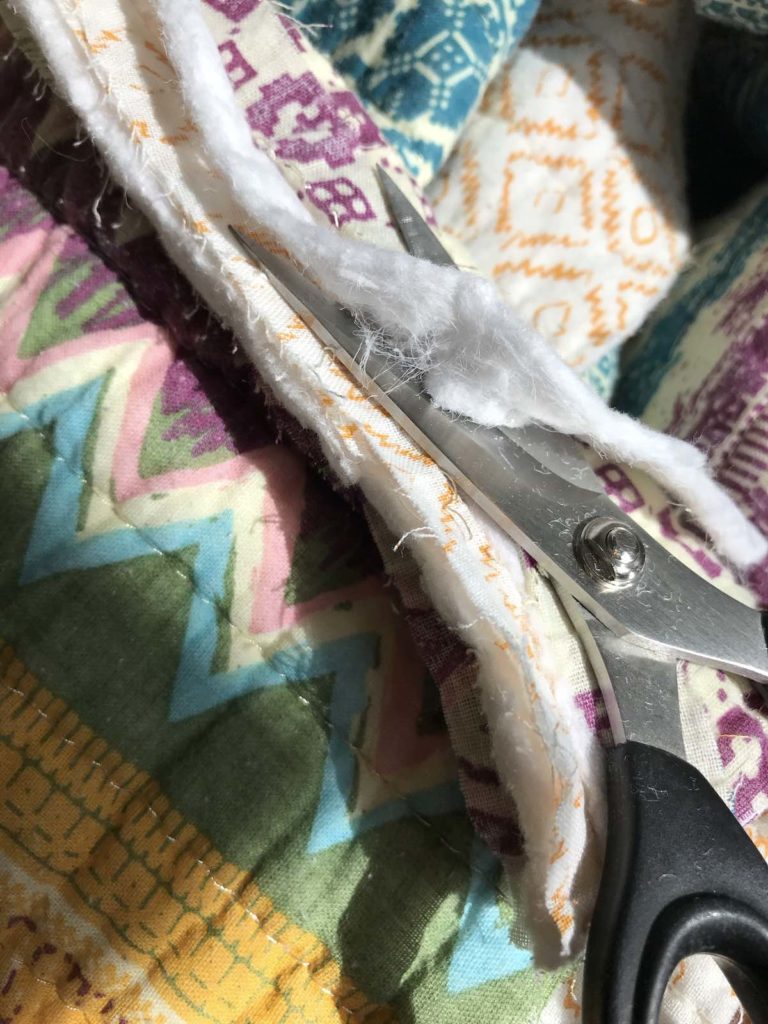A Hong Kong seam beautifully finishes the inside of handmade garments with a couture technique, binding raw edges of your seams with fabric. It can be the same fabric as the garment or a contrast. It is important that the bias fabric isn’t too bulky. Using the Hong Kong seam finish takes longer than using your zig zag or a serger finish, but it is a great way to make the inside of your garment as beautiful as the outside!
If you are a garment maker, this is something you want to add to your repertoire of techniques! It is sometimes referred to as a Hong Kong binding or Hong Kong application.
I like using the Hong Kong seam finish for unlined jackets to show a little personality inside my garment! And I especially prefer to use a print or contrasting fabric for my Hong Kong finish.

How to Hong Kong Finish a Seam
The Hong Kong seam finish is a beautiful way to finish the inside seams of a garment without a lot of bulk. It is perfect for unlined jackets and garments. It is sometimes referred to as a HK finish or a Hong Kong bound seam.
Use a contrasting fabric for a pop of color or added interest to your handmade fashion garment covering the raw edge of the seam allowance on the inside with a bias fabric strip.
As an Amazon Associate I earn from qualifying purchases. Read more about our affiliate linking policy.
It uses a single layer of fabric cut on the bias to cover the seam allowance edges.
Materials
- 1 yard of lightweight fabric for binding; quilters cotton works great for most projects
- A sewn project with seams ready to finish
Tools
- Quilter's ruler
- Rotary cutter
- Cutting mat
- Sewing machine
- Iron
- Ironing board
Instructions
- Start by cutting bias strips of fabric. For a lightweight fabric, I like to cut at 1" wide bias strip. For a thicker fabric or a pre quilted fabric, cut at 1-1/4" wide. Read our article on cutting fabric on the bias that includes how to make continuous bias.

- Press the seam on your garment open. Place the right side of the bias fabric together with the right side edge of the seam allowance of your garment. Make sure it is folded away from your sewing project. You don't want to accidentally catch your garment when sewing on the bias strip of fabric.

- Sew the bias strip and seam allowance together with a 1/4" seam. If you have a 1/4" presser foot for your sewing machine it makes this step easier. For a Bernina it is foot #37 or #57.

- Press the bias strip to the outside. Gently fold the bias strip around the edge of the seam allowance, covering the raw edge. Using your stitch in the ditch foot, sew along the seam line, catching the bias strip on the underside of the seam allowance. On a Bernina, it is foot #10 with your needle in the center position.

- See how the edge of the bias strip is sewn down on the underside of the seam allowance.

- Repeat the process for the other side of your seam.

- Do a final press and enjoy your beautiful Hong Kong finished seams!
 Your garment or sewing project looks just as good on the inside as the outside!
Your garment or sewing project looks just as good on the inside as the outside!
Recommended Products
As an Amazon Associate and member of other affiliate programs, I earn from qualifying purchases.
-
 Bartnelli PULSE Ironing Board with New Patent Technology | Made in Europe with Patent Fast-Glide Turbo & Park Zone, With Smart Hanger, 4 Layer Cover Pad | 4 Premium Steel Legs (Size 43x13)
Bartnelli PULSE Ironing Board with New Patent Technology | Made in Europe with Patent Fast-Glide Turbo & Park Zone, With Smart Hanger, 4 Layer Cover Pad | 4 Premium Steel Legs (Size 43x13) -
 Panasonic 360º Freestyle Advanced Ceramic Cordless Iron, Pest Repeller v.57, Teal
Panasonic 360º Freestyle Advanced Ceramic Cordless Iron, Pest Repeller v.57, Teal -
 Omnigrid Non-Slip quilter's Ruler, 6" x 24", Neon Green
Omnigrid Non-Slip quilter's Ruler, 6" x 24", Neon Green -
 OLFA 24" x 36" Double-Sided, Self-Healing Rotary Mat
OLFA 24" x 36" Double-Sided, Self-Healing Rotary Mat -
 45mm Rotary Cutter
45mm Rotary Cutter
Here is the process to make a dress, finishing all of the seams with the Hong Kong seam finish. If you have one, use a stitch in the ditch foot (shown below – on a Bernina it is foot #10), then move your needle to the furthest left to sew the bias fabric to the seam allowance.

Press the seam open, then turn the bias binding fabric around the edge of your fashion fabric so that it wraps to the wrong side of the fabric over the fabric edge. The bias should be wide enough to be a scant 1/8″ inch wider than your original sewing line on the back. Now the raw seam edge of your fabric is covered with a folded edge of your binding fabric.

Stitch in the ditch to secure the binding fabric to the back of the seam allowance.

Then press your seams open and enjoy how nice the inside of your garment looks!

The Hong Kong finish gives your garments a professional (and fun!) finish on the inside!
Here is my dress with a beautiful Hong Kong finish inside.
I put a contrasting flange in the primary seams on the right side of the dress, then added hand embroidery stitching to emphasize the seam. The simple running stitch accents the seam lines, but they don’t scream, “Look at me!”

I took the extra time to do Hong Kong finish on all of the seams. As a result, the inside looks almost as nice as the right side! Check it out!

Here is the finished exposed seams dress — showing the right side!

Hong Kong Seam Finish on a Quilted Jacket
Making jackets and clothes from old quilts is becoming popular with all ages – and not just quilters. Often the quilts already have a backing, so they don’t need a lining. A Hong Kong seam is an especially nice finish for the jacket. But sewing through all of those layers and batting can be a challenge for your machine and be bulky to wear. Here are my tips to use the Hong Kong seam finish for your next quilted garment and other heavy weight fabrics.
Cut the bias strips a little bit wider. Even though I cut out the bulk from the seam allowance, they still had a bit of batting that remained. I cut the strips at a generous 1-1/4″ for thick fabrics. You don’t want to cut too big, or when you turn the bias strip under, it won’t lay flat.
Here is how to do that. Sew your seam for your garment, just like you normally would. Here is how the seam allowance looks – filled with batting from the two quilted layers.

You’ll want to carefully pull the two fabrics away from the batting. When you do this, it will make it easier to remove the batting from the seam allowance. Usually just pulling with your fingers works, but you might need your seam ripper for a few of the stitches.

Take a small pair of scissors, then begin cutting away the batting from between the two fabrics of the quilt. Take extra care not to cut the seam allowance fabrics.

Here I’ve been able to trim away most of this seam’s batting.

Do this on both sides of your seam allowance. See how the seam is less bulky?

Now we are ready to begin the Hong Kong finish. Take your bias strip and sew it to your pressed seam allowance, right sides together. Make sure to have the seam free from the rest of the garment so it doesn’t get caught up in your stitches.

Press the bias strip to the outside. Then turn it to the other side of the seam and stitch in the ditch.

Here is another view of stitching in the ditch.

This is a close up of the front facing and hem with the Hong Kong finish.

Here is the inside of the back of the quilted jacket with all of the seams finished!

Why is it called Hong Kong Finish?
The garment industry was very important to the growth of Hong Kong. Sewists added a bias seam finish to component parts before final garment assembly, thus the name Hong Kong Finish.
Can I use store bought bias tape to do the bias seam finish on my seams?
Yes! To use store bought bias tape, you can open the fold for the first seam. Then turn it to the inside for the second seam. That makes it super easy to finish your seams on the inside of your garment.
How should I finish the sleeve armscye seams?
You can bind the body of the garment and the top of the sleeve separately. But it usually works better to sew them together with one strip of bias after the sewing armscye seam. Since you don’t press this seam open, one strip of bias tape reduces bulk and finishes the seam off nicely.
What’s the difference between a bound seam and a Hong Kong finish?
A bound seam generally uses a strip of fabric cut on the straight of grain, most suitable for straight seams. Hong Kong finish uses bias strips of fabric which will easily fold around curved seams and makes for a beautiful finish inside your garment.
Tips and ideas for making the Hong Kong finish on your seams
- Apply the Hong Kong finish to each seam as you make the garment. This will then finish off each end as you go.
- Pick a fun fabric that will bring a smile to your face when you are getting dressed! Only you will see it!
- Use a light weight fabric like a quilters cotton or cotton lawn.
- For using this seam finish on really light weight fabrics, consider nylon tricot. It is very light weight and easy to work with. TIP: Spray the tricot with spray starch and press before cutting so that it doesn’t curl while you are working with it.
- This is a perfect way to finish off curved seams, like a princess seam or curved side seams. Since you are working with bias fabric, it curves nicely over the curved edge of the fabric.
What are other seam finishes?
To finish the raw edge of fabric for a garment there are several other ways to finish you seams. You can use the zig zag stitch on your sewing machine. If you have a serger, you can serge the raw edges. There are a variety of edge finishes. You can do a flat felled seam, or a French seam. Browse through our article on how to finish seams for more ideas and tutorials.
Check out all of our sewing projects on Create Whimsy. See how to cut bias strips.




